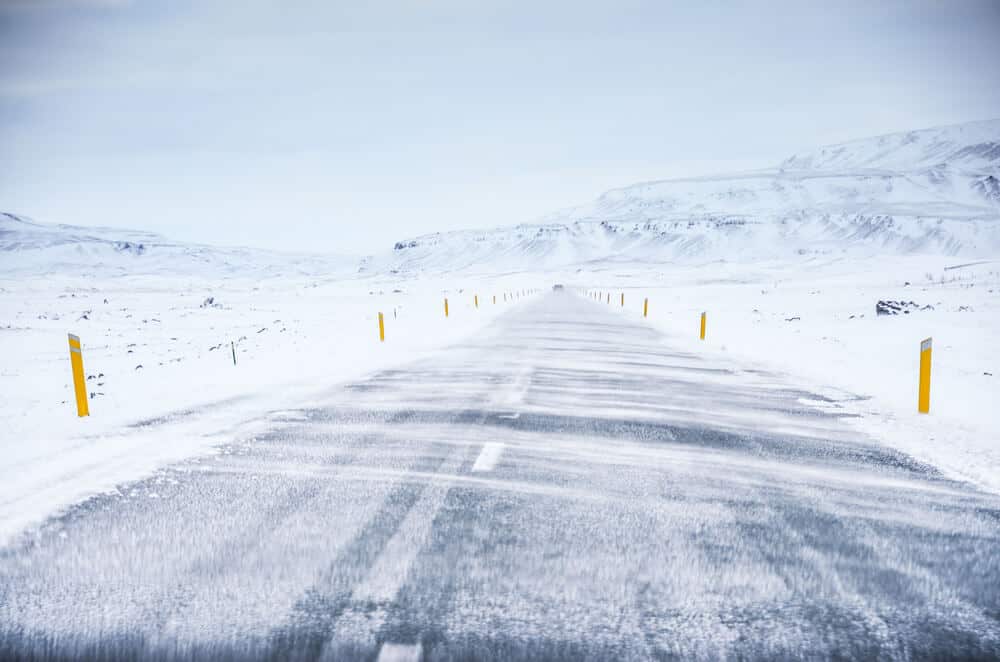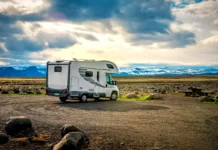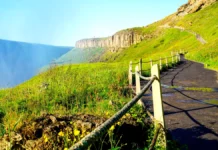One of the mistakes first-timers make when visiting Iceland is underestimating just how windy it really gets. Are we talking gentle breezes? Or are gale force winds a more suitable description? I’ll let you judge for yourself. A quick glance at this week’s wind forecast for Reykjavik shows wind speeds between 13-32 mph (21-51 km/h). So while it’s not exactly hurricane strength winds (although Iceland does experience those), the gusts in Iceland are definitely strong enough to make you lose balance on your bike and blow you over or in extreme cases knock you down to the ground. And let’s not forget, with temperatures hovering between the 30s-50s ºF (-1 to 10 ºC) most of the year, Iceland’s gusts also contribute to wind chill. So how windy does it get in Iceland? And what are some tips to help you while traveling and driving on this small, stormy island?

Iceland: A Little Island With a Nordic Climate
Iceland’s proximity to the Arctic Circle means it has cold weather most of the year. Thankfully, extremely frigid temperatures are somewhat negated by the warming waters of the Gulf Stream. Iceland is known for its unpredictable climate. Between rainstorms, hail storms, snow storms, sleet, volcanic ash, sand, and pretty much anything else Mother Nature can throw with you, the elements and climate here are harsh. When planning a trip to Iceland, it’s important to research the weather, average temperatures, rainfall, and climate in general. The wind is yet another factor to consider. You need to be prepared and know what to expect with Iceland’s wind so you don’t get unexpectedly lashed in the face.
Exactly How Windy Does It Get in Iceland?
I’ll be perfectly honest with you; Iceland’s wind can get a little scary. When things really kick up, there will be days when you have to hold on to upright objects such as signposts or fences in order to keep your balance. It does actually feel as though the wind is trying to knock you to the ground. When the wind starts to approach 30 or 40 miles per hour (48-64 km/h), it’s best to stay inside. No driving or even trying to cross the street. Things are even more complicated when there’s a serious storm. I don’t want to scare you, but Iceland has had Category 4 hurricane force winds during extremely powerful storms. There was one in 2015 near Vik with 141 mph (226 km/h) winds. Many tourists got stuck or blown off the road because they did not heed the advisories and weather warnings.
Tools for Dealing with Iceland’s Crazy Wind and Climate
If an Icelander warns you that it’s going to get really windy, believe them. They’ve dealt with this weather their whole lives, and they know what they’re talking about. You can check the Icelandic Meteorological Office and the Road and Coastal Administration for severe weather warnings. These websites need to be bookmarked as you should be checking them at least once a day (or more) during your travels. You want to ensure that your destination or the area where you’re traveling has no advisories or weather warnings.
Visit sites like windfinder.com and weather.com to you where winds are strongest. There are several websites to look up the wind forecast for specific cities. TripAdvisor forums also have some helpful threads about Iceland’s weather.

I hope I haven’t frightened you too much. Iceland is not all wind, all the time. There are relatively mild days wind speeds reach 10-15 mph (16-24 kph). This is much more typical, but I do want you to be prepared in case you encounter really high winds outside of cities like Reykjavik.
Driving in Iceland’s Wind
You’ll definitely need to practice for caution when driving in Iceland. This is especially true when it comes to the wind. Much of the Ring Road consists of wide stretches of open highway. There are usually no trees to act as wind barriers, and the mountains are off in the distance. It’s just you, your car, and the wind. Many a driver has had to fight with their steering wheel or has been forced off the road due to strong winds. And I’m not even taking into account the sandstorms and ash storms the country is so famous for. When driving in Iceland, you should not only be checking the weather forecast on at least a daily basis. You also need to check the wind forecast, especially if you are driving long distances on the open highway. You don’t want to get blown over or blown off the road.
Another piece of advice that may not occur to people when dealing with windiness in Iceland is car doors. Picture this: You decide to pull over for a quick photo stop of the stunning landscapes surrounding you. It will only take a few seconds, so you step out of your vehicle and leave the door ajar. Suddenly, in comes a gust of wind so strong that it bends the door back on its hinges. In a matter of moments, you’ve gone from having a perfectly intact car rental to one with damaged doors that are expensive to repair and replace. Do yourself a favor and try not to find yourself in this easy-to-avoid scenario. When you step out of your car, even for just a second, make sure the doors are closed. And when stepping out in windy conditions, use both hands to hold the door and keep it steady.
Is It Too Windy to Go Tent Camping in Iceland?
While camping is a popular activity in Iceland, all of these tales of super strong gusts of wind might have you wondering if you can actually camp overnight in a tent. While you technically can, I wouldn’t recommend doing it outside of the summer season. Remember, in order to face the wind you will need to drive long tent stakes deep into the ground. No one wants to be like Dorothy in Wizard of Oz as her house gets carried away by a cyclone. You also have to set up and take down your tent. If you arrive at the campsite in the middle of a snowstorm, it’s not exactly ideal. A helpful tip is to place your tent up against a solid, horizontal surface. Look for a tree, a large rock, a hill, or a hedge to help provide a natural wind barrier. If your car is close by, that’s also an option.

So what’s the alternative to tent camping in Iceland? An extremely popular route that many people choose is to rent a campervan. You’ve really got the best of both worlds. On one hand, you have the option of carrying a tent with you and setting up camp for the night. But if conditions worsen and things get really bad, you can always sleep in your heated camper overnight.
Regardless of the time of year you come, be sure to pack an all-season tent. And if you plan on tent camping, have a back-up plan like sleeping in your car.
Iceland’s Weather and Climate: How Windy Does it Really Get?
I hope Iceland’s wind doesn’t catch you off guard. Hopefully, after reading this article, you’ll have a better idea of the scope of what you’re getting into. Iceland is a low crime country, so the largest threats and hazards posed are by natural phenomena and the weather. You need to practice precaution when driving. The smaller and lighter your vehicle, the greater the chance that the wind will push you around on the road. When traveling outside cities and towns, which have buildings as natural wind barriers, use common sense and the websites listed above. Leave extra time in your itinerary in case you need to wait out a really bad storm. In Iceland, it’s always better to be safe than sorry.


































